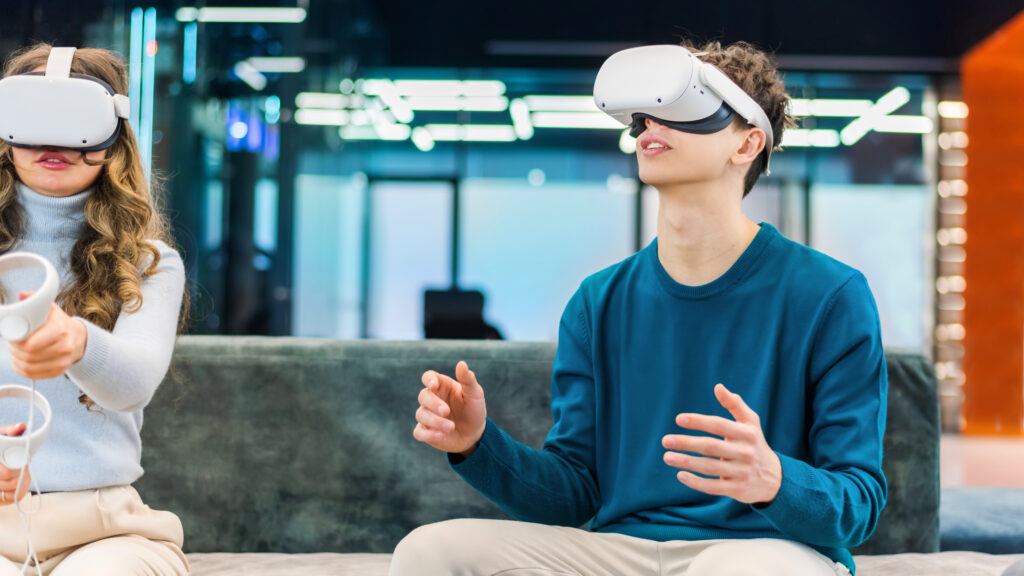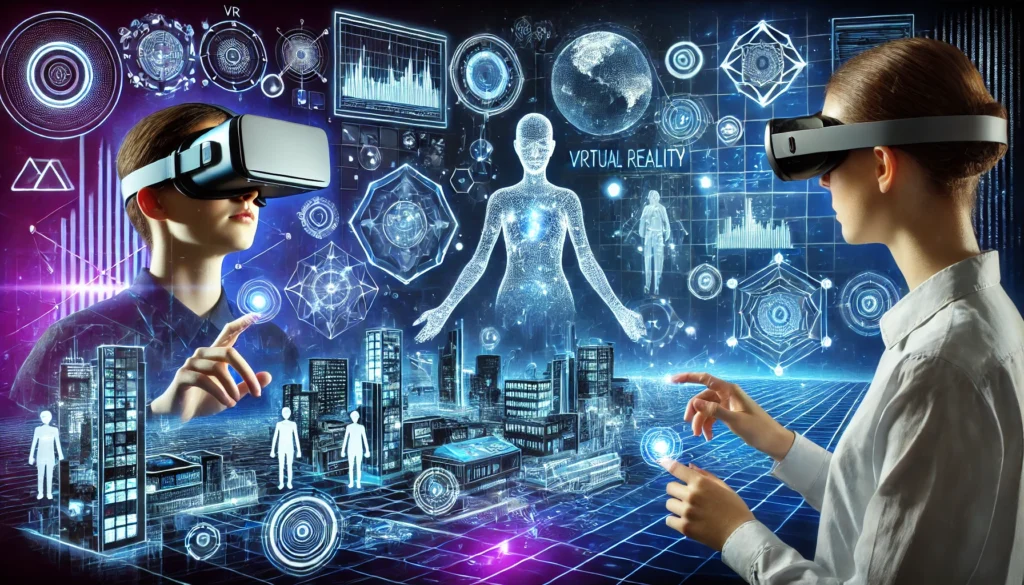The gaming industry is pushing its boundaries and limits due to new innovations and technological advancements. Virtual reality (VR) and augmented reality (AR) are playing a vital role in taking the gaming experience to the next level. VR & AR are changing the shape and level of the gaming industry with stunning and immersive experiences that have blurred the line between real life and the digital world.
These technologies are creating a new path for gaming players to feel, interact and experience unparalleled reality. VR headsets like the Oculus Quest 3, PlayStation VR2, and Apple Vision Pro are already available in the market, which is a great example of technology and innovation and holds the future of the gaming industry.
In this article, we will explore how VR and AR technologies are bringing a revolution in the gaming industry in 2025 by providing amazing features that will give a different feel to the gaming experience. Whether you are a casual gamer, a competitive gamer or a tech enthusiast, in this article, we will know why Virtual reality (VR) and augmented reality (AR) are dominating today and how they are and will shape and change the gaming industry in the future.
Ready to dive into the World of VR & AR? 🙂
The Evolution of VR & AR in Gaming

The first virtual reality (VR) system came in 1962 called Sensorama. It laid the foundation ground for the VR technologies we enjoy today. Though Sensorama didn’t achieve much commercial success at that time, it paved the way for the future of this technology.
VR technology gained popularity in the market in 2016 with the launch of Oculus Rift & HTC Vive while AR got a breakthrough with Pokemon GO which was launched in 2016. Both of these gained a lot of craze and popularity during that time with this breath-taking technology. These VR and AR technologies gave the people a new perspective of digital world with immersive experience which reduced the distance between real world and digital world.
Major Breakthroughs: VR & AR Gaming History
- 1962: Sensorama gets launched and laid the foundation.
- 2016: Launch of HTC Vive & Oculus Rift, paving the path for immersive VR gaming.
- 2017: Sony launched its 1st VR: PlayStation VR fr console gamers.
- 2020: Valve launched Half-Life: Alyx, 1st game with VR’s potential for deep storytelling
- 2023: Tech Giant “Apple” launched its 1st ultra-high resolution mixed-reality headset: Apple Vision Pro.
- 2023: Sony launched it’s 2nd VR headset: PlayStation VR2, with improvements inresolution, eye tracking and adding haptic feedback to enhance gaming experience.
- 2024: Meta Quest 3 developed by Reality Labs (Meta Platform) gets launched – a standalone virtual reality (VR) headset with hand-tracking & better graphics
VR & AR: Enhancing Gaming Experiences

Immersion and Realism
VR allows players to physically interact with the environment, creating an immersive and engaging experience. VR fully immerses players in the digital world, creating a unique and unparalleled presence with realistic movements. AR merges digital elements with the real world to enhance the gaming experience, rather than replacing it like VR does. This allows players to interact with virtual objects or the world without losing their surroundings.
Social Interactions
Multiplayer games such as VRchat and Rec Room allow players to play in virtual spaces or join shared virtual spaces. This makes online gaming more-lively and develops social connections that are not possible in traditional games.
Fitness & Physical Interaction
VR isn’t just for entertainment anymore; it now encourages physical activity and fitness. Games such as Supernatural and Beat Saber involve physical activity along with gaming, making VR a tool that contributes to fitness and health benefits.
VR Esports and Competitive Gaming
With the advances in VR technology, Esports is also expanding into the field of VR. Games such as Echo VR and Blaston allow players to move physically and strategize in a 3D virtual space. Simultaneously, competitive gaming is also enhancing and leaping up, opening up a new door of opportunities for professional players.
Augmented Reality’s(AR): Impact on Mobile Gaming
AR technology has made a significant impact in the gaming industry, especially in the mobile gaming industry. AR has helped transform and enhances the mobile gaming experience by merging digital world and real-world experiences. Games such as Pokémon Go and Minecraft Earth are the best examples of AR, where players can interact and engage with virtual elements with the help of their phone cameras, pushing the boundaries of AR technology. With the passage of time, AR is becoming more advanced & improved leading to rise in the demand of AR glasses in the market for getting the feel of immersive experience of the digital gaming world.
AR in Console & PC Gaming
AR technology is mainly widespread on mobile platforms, which is more focused on mobile gaming. Giant leading companies like Microsoft and Sony are exploring the potential of AR on PCs and consoles. Microsoft’s HoloLens features mixed reality applications that allow players to engage and interactive gameplay in real-world environments. Meanwhile, Sony has experimented with AR gaming with its PlayStation titles featuring camera-based motion tracking & interactive AR experiences. AR technology along with AR accessories is continuing to develop over time with improved processing capabilities and features which will further help in the integration of AR technology into mainstream gaming in the future.
Challenges: VR & AR Gaming

Rise, continued growth & popularity, Despite all this, Virtual Reality (VR) and Augmented Reality (AR) are facing some challenges.
High Cost
VR headsets and accessories are often on expensive side.
- Apple Vision Pro: $ 3,499
- Meta Quest 3: $499
- PlayStation VR2: $399.99
- Note: Prices are as of Mar, 2025 and subject to change and may vary by region.
Motion Sickness
Some players feel discomfort caused by movement tracking issues.
Limited Game Library
Despite the popularity, VR/AR game library remains lower than traditional platform especially for AAA titles.
Hardware Limitations
To enjoy the full potential of advanced VR/AR games, it often requires high-performance next-gen consoles or PCs.
The Future of VR & AR in Gaming

The industry is shifting forward with a greater focus on bringing more affordable, lightweight and wireless VR headsets into the market. The advancement emphasizing on improved haptic feedback, AI integration and enhancements for immersive dynamic digital world experiences.
The integration and advancement of 5G connectivity and cloud gaming will make VR and AR games more accessible to a wider audience along with mainstream gaming in the future. As per prediction of Gartner, by 2030, 70% of the gaming will integrate XR(extended reality), that’s merging AR, VR and mixed reality.
Research Papers on AR & VR in Gaming
Graphs

(Source credit: Statista)

(Source credit: Statista)
Conclusion

VR and AR technologies are revolutionizing the gaming industry setting new standards of gaming with unparalleled immersiveness and interactivity in 2025. As technology advances, gaming will become more realistic, immersive and engaging than ever. VR worlds or interactive AR elements will completely transform & redefine the gaming landscape and experiences in the times to come. Challenges like cost of VR and comfort remain, but hopefully ongoing innovations in rapid growth will close this gap in the future.
Connect with GamesNerdz for more latest Gaming news and tips!!!

